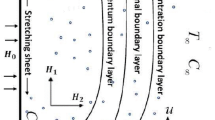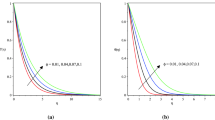Abstract
This study investigates the impact of various shapes of \(F{e}_{3}{O}_{4}\) and \(A{l}_{2}{O}_{3}\) nanometers immersed in water \(({H}_{2}O)\) base fluid over an unsteady vertically curved stretching surface. The article also covers the effects of velocity slip and variable magnetohydrodynamics (MHD). The mathematical model is based on fundamental principles, specifically the conservation of mass, momentum, and energy. We have transformed the modeled governing partial differential equations into highly nonlinear ordinary differential equations using suitable similarity conversions. The BVP4C program in MATLAB is used to generate numerical solutions for significant physical parameters, which can be visualized as graphs. The bar graphs are also drawn to analyze the impact of physical emerging parameters on skin friction coefficient and Nusselt Numbers. The result is also validated by comparing the present results with the available literature and found to be in good accord. It has been found that the addition of \(F{e}_{3}{O}_{4}\) and \(A{l}_{2}{o}_{3}\) nanoparticles improves the thermal conductivity of the base fluid \({H}_{2}O\). This rise is more pronounced for platelet-shaped \(F{e}_{3}{O}_{4}\) nanoparticles. The shape and the size of the nanoparticles play a crucial role in the heat transfer mechanism. Furthermore, the brick-shaped \(A{l}_{2}{O}_{3}-{H}_{2}O\) nanofluid exhibits the lowest velocity, the greatest temperature, and the lowest skin friction coefficient.



















Similar content being viewed by others
Abbreviations
- \(r,s,z\) :
-
Curvilinear coordinates
- \(U\) :
-
Stretching velocity \([{{\text{ms}}}^{-1}]\)
- \(k\) :
-
Thermal conductivity \(\left[{{\text{Wm}}}^{-1}{{\text{K}}}^{-1}\right]\)
- \({C}_{p}\) :
-
Specific heat \([{{\text{Jkg}}}^{-1} {{\text{K}}}^{-1} ]\)
- \(\kappa\) :
-
Slip parameter
- \(S\) :
-
Unsteady parameter
- \(M\) :
-
Magnetic parameter
- \({B}_{0}\) :
-
Strength of magnetic field
- \(T\) :
-
Fluid temperature \([{\text{K}}]\)
- \(F{e}_{3}{O}_{4}\) :
-
Ferrous ferric oxide or Iron oxide
- \(A{l}_{2}{O}_{3}\) :
-
Aluminum oxide
- \({H}_{2}O\) :
-
Hydrogen oxide (water)
- \(a, \alpha , L\) :
-
Positive dimensional constants \([{{\text{s}}}^{-1}]\)
- \(\theta\) :
-
Non-dimensional temperature
- \(\sigma\) :
-
Electrical conductivity \([{{\text{Sm}}}^{-1}]\)
- \(\rho\) :
-
Density \([{{\text{kgm}}}^{-3}]\)
- \(\alpha\) :
-
Thermal diffusivity
- \(m\) :
-
Shape factor
- R:
-
Radius of curvature
- \({C}_{{f}_{s}}\) :
-
Local skin friction coefficient
- \(N{u}_{s}\) :
-
Local Nusselt number
- \(Gr\) :
-
Grashof number
- \(K\) :
-
Curvature
- \(Pr\) :
-
Prandtl number
- \(\mu\) :
-
Dynamic viscosity \([{{\text{kgm}}}^{-1}{{\text{s}}}^{-1}]\)
- \(u,v\) :
-
Components of velocity [\({{\text{ms}}}^{-1}\)]
- \(P\) :
-
Pressure \([{{\text{kgm}}}^{-1}{{\text{s}}}^{-2}]\)
- \(\phi\) :
-
Volumetric fraction
- \(\eta\) :
-
Non-dimensional space variables
- \(\tau\) :
-
Sheer stress \([{{\text{Nm}}}^{-2}]\)
- \({q}_{w}\) :
-
Heat flux \([{{\text{Wm}}}^{-2}]\)
- \(\nu\) :
-
Kinematic viscosity \([{{\text{m}}}^{2}{{\text{s}}}^{-1}]\)
- BL:
-
Boundary layer
- \(MHD\) :
-
Magnetohydrodynamic
- \(nf, f\),ref:
-
Nanofluid, fluid, reference
- \(s\) :
-
Solid nanoparticles
References
Abdulwahab MI, Thahab SM, Dhiaa AH (2016) Experimental study of thermophysical properties of TiO2 nanofluid. Iraqi J Chem Petrol Eng 17(2):1–6
Ahmad S, Ameer-Ahammad N, Naveed-Khan M, Algehyne EA, Tag-Eldin E, Gepreel KA, Guedri K (2022) and Galal AM (2022) Thermal and solutal energy transport analysis in entropy generation of hybrid nanofluid flow over a vertically rotating cylinder. Front Phys. https://doi.org/10.3389/fphy.2022.988407
Bhattacharyya K, Layek GC (2014) Magnetohydrodynamic boundary layer flow of nanofluid over an exponentially stretching permeable sheet. Phys Res Int 2014:1–12
Bibi S, Elahi Z, Shahzad S (2020) Impacts of different shapes of nanoparticles on SiO2 nanofluid flow and heat transfer in a liquid film over a stretching sheet. AJP 95(11):115217
Buongiorno J (2006) Convective transport in nanofluids. J Heat Transfer 128(3):240–250
Choi SUS, and Eastman JA (1995) Enhancing thermal conductivity of fluids with nanoparticles. No. ANL/MSD/CP-84938; CONF-951135-29. Argonne National Lab.(ANL), Argonne, IL (United States)
Crane LJ (1970) Flow past a stretching plate. Zeitschrift Für Angewandte Mathematik Und Physik ZAMP 21:645–647
Hayat AU, Ullah I, Khan H, Weera W, Galal AM (2022) Numerical simulation of entropy optimization in radiative hybrid nanofluid flow in a variable features darcy-forchheimer curved surface. Symmetry 14(10):2057
Hayat AU, Ullah I, Khan H, Alam MM, Hassan AM, Khan H (2023) Numerical analysis of radiative hybrid nanomaterials flow across a permeable curved surface with inertial and Joule heating characteristics. Heliyon 9(11):e21452
Hayat U, Shaiq S, Shahzad A, Khan R, Kamran M, Shah NA (2023) The effect of particle shape on flow and heat transfer of ag-nanofluid along stretching surface. Chin J Phys 85:708–721
Khan WA, Pop I (2010) Boundary-layer flow of a nanofluid past a stretching sheet. Int J Heat Mass Transf 53(11–12):2477–2483
Khan MN, Akkurt N, Ahammad NA, Ahmad S, Amari A, Eldin SM, Pasha AA (2022a) Irreversibility analysis of Ellis hybrid nanofluid with surface catalyzed reaction and multiple slip effects on a horizontal porous stretching cylinder. Arab J Chem 15(12):104326
Khan N, Shafiq Ahmad M, Ameer Ahammad N, Alqahtani T and Algarni S (2022b) Numerical investigation of hybrid nanofluid with gyrotactic microorganism and multiple slip conditions through a porous rotating disk. Waves in Random and Complex Media 1–16
Kierzenka J (1998) Studies in the numerical solution of ordinary differential equations, PhD Thesis, Southern Methodist University, Dallas, TX
Kole M, Dey TK (2013) Enhanced thermophysical properties of copper nanoparticles dispersed in gear oil. Appl Thermal Eng 56(1–2):45–53
Kuznetsov AV, Nield DA (2014) Natural convective boundary-layer flow of a nanofluid past a vertical plate: a revised model. Int J Therm Sci 77:126–129
Li Y-M, Ullah I, Alam MM, Khan H, Aziz A (2022) Lorentz force and Darcy-Forchheimer effects on the convective flow of non-Newtonian fluid with chemical aspects. Waves Random Complex Media. https://doi.org/10.1080/17455030.2022.2063984
Mahapatra TR, Gupta AS (2003) Stagnation-point flow towards a stretching surface. Can J Chem Eng 81:258–263
Makinde OD, Khan ZH, Ahmad R, Khan WA (2018) Numerical study of unsteady hydromagnetic radiating fluid flow past a slippery stretching sheet embedded in a porous medium. Phys Fluids 30(8):083601
Maraj EN, Iqbal Z, Shaiq S (2018a) Extraordinary role of hydrogen possessions and viscosity variation in electrically conducting copper and silver nanoparticles inspired by mixed convection. Int J Hydro Energy 43(24):10915–10925
Maraj EN, Shaiq S, Iqbal Z (2018b) Assessment of hexahedron and lamina shaped graphene oxide nanoparticles suspended in ethylene and propylene glycol influenced by internal heat generation and thermal deposition. J Mol Liquids 262:275–284
Naveed M, Abbas Z, Sajid M (2016) Hydromagnetic flow over an unsteady curved stretching surface. Eng Sci Technol Int J 19(2):841–845
Navier CLMH (1823) Mémoire sur les lois du mouvement des fluides. Mémoires De L’académie Royale Des Sciences De L’institut De France 6(1823):389–440
Nguyen MD, Tran H-V, Xu S, Lee TR (2021) Fe3O4 nanoparticles: structures, synthesis, magnetic properties, surface functionalization, and emerging applications. Appl Sci 11(23):11301
Qin L, Ahmad S, Khan MN, Ahammad NA, Gamaoun F, Galal AM (2022) Thermal and solutal transport analysis of Blasius–Rayleigh–Stokes flow of hybrid nanofluid with convective boundary conditions. Waves Random Complex Media. https://doi.org/10.1080/17455030.2022.2072018
Saidur R, Leong KY, Mohammed HA (2011) A review on applications and challenges of nanofluids. Renew Sustain Energy Rev 15(3):1646–1668
Sakiadis BC (1961) Boundary-layer behavior on continuous solid surfaces: I. Boundary-layer equations for two-dimensional and axisymmetric flow. AIChE J 7(1):26–28
Saranya S, Ragupathi P, Al-Mdallal Q (2022a) Analysis of bio-convective heat transfer over an unsteady curved stretching sheet using the shifted Legendre collocation method. Case Stud Thermal Eng 39:102433
Saranya S, Baranyi L, Al-Mdallal QM (2022b) Free convection flow of hybrid ferrofluid past a heated spinning cone. Thermal Sci Eng Progress 32:101335
Shahzad A, Liaqat F, Ellahi Z, Sohail M, Ayub M, Ali MR (2022) Thin film flow and heat transfer of Cu-nanofluids with slip and convective boundary condition over a stretching sheet. Sci Rep 12(1):14254
Shaiq S, Maraj EN (2019) Role of the induced magnetic field on dispersed CNTs in propylene glycol transportation toward a curved surface. Arab J Sci Eng 44(9):7515–7528
Shaiq S, Maraj EN, Mehmood R, Ijaz S (2022) Magnetohydrodynamics radiative dissipative slip flow of hydrogen-oxide (H2O) infused with various shape tungsten, tin, titanium (nanometer) particles over a nonlinear radial stretching surface. Proc Inst Mech Engineers Part E 236(3):953–963
Shaiq S, Maraj EN, Shahzad A (2023) An unsteady instigated induced magnetic field’s influence on the axisymmetric stagnation point flow of various shaped copper and silver nanomaterials submerged in ethylene glycol over an unsteady radial stretching sheet. Numer Heat Transfer Part A. https://doi.org/10.1080/10407782.2023.2193351
Shampine LF, Kierzenka J, Reichelt MW (2000) Solving boundary value problems for ordinary differential equations in MATLAB with bvp4c. Tutor Notes 2000:1–27
Suriya Uma Devi S, Anjali-Devi SP (2016) Numerical investigation of three-dimensional hybrid Cu–Al2O3/water nanofluid flow over a stretching sheet with effecting Lorentz force subject to Newtonian heating. Can J Phys 94(5):490–496
Tiwari RK, Das MK (2007) Heat transfer augmentation in a two-sided lid-driven differentially heated square cavity utilizing nanofluids. Int J Heat Mass Transfer 50(9–10):2002–2018
Ullah I (2022a) Activation energy with exothermic/endothermic reaction and Coriolis force effects on magnetized nanomaterials flow through Darcy-Forchheimer porous space with variable features. Waves Random Complex Media. https://doi.org/10.1080/17455030.2021.2023779
Ullah I (2022b) Heat transfer enhancement in Marangoni convection and nonlinear radiative flow of gasoline oil conveying Boehmite alumina and aluminum alloy nanoparticles. Int Commun Heat Mass Transfer 132:105920
Ullah I, Hayat T, Alsaedi A (2022) Optimization of entropy production in flow of hybrid nanomaterials through Darcy-Forchheimer porous space. J Therm Anal Calorim 147(10):5855–5864
Ullah S, Ullah I, Ali A (2023a) Soret and Dufour effects on dissipative Jeffrey nanofluid flow over a curved surface with nonlinear slip, activation energy, and entropy generation. Waves Random Complex Media. https://doi.org/10.1080/17455030.2022.2164380
Ullah I, Alam MM, Shah MI, Weera W (2023b) Marangoni convection in dissipative flow of nanofluid through porous space. Sci Rep 13(1):6287
Ullah I, Shukat S, Albakri A, Khan H, Galal AM, Jamshed W (2023c) Thermal performance of aqueous alumina–titania hybrid nanomaterials dispersed in rotating channel. Int J Modern Phys B 37:2350237
Xia W-F, Ahmad S, Naveed-Khan M, Ahmad H, Rehman A, Baili J, Gia TN (2022) Heat and mass transfer analysis of nonlinear mixed convective hybrid nanofluid flow with multiple slip boundary conditions. Case Stud Thermal Eng 32:101893
Author information
Authors and Affiliations
Contributions
Shakil Shaiq Modled the Problem and also wrote the discussion section. Azeem Shahzad wrote the Introduction Section and Numerical Procedure. Umer Hayat Prepared all the Figures. All authors reviewed the manuscript.
Corresponding author
Ethics declarations
Conflict of interest
The authors state that there are no potential conflicts of interest.
Additional information
Publisher's Note
Springer Nature remains neutral with regard to jurisdictional claims in published maps and institutional affiliations.
Rights and permissions
Springer Nature or its licensor (e.g. a society or other partner) holds exclusive rights to this article under a publishing agreement with the author(s) or other rightsholder(s); author self-archiving of the accepted manuscript version of this article is solely governed by the terms of such publishing agreement and applicable law.
About this article
Cite this article
Shaiq, S., Shahzad, A. & Hayat, U. A comparative investigation of magnetohydrodynamics slip \(F{e}_{3}{O}_{4}-{H}_{2}O\) and \(A{l}_{2}{O}_{3}-{H}_{2}O\) nanofluids flow and heat transfer over an unsteady vertically curved stretching surface. Multiscale and Multidiscip. Model. Exp. and Des. (2024). https://doi.org/10.1007/s41939-023-00352-9
Received:
Accepted:
Published:
DOI: https://doi.org/10.1007/s41939-023-00352-9




